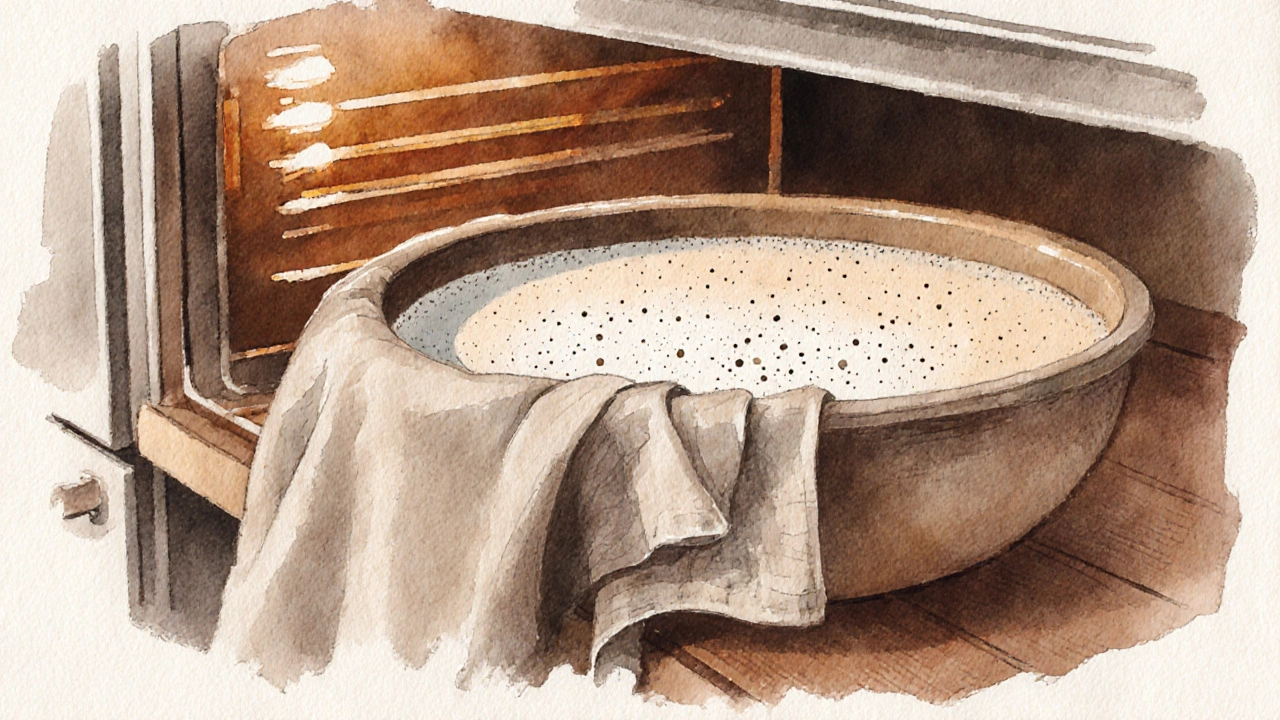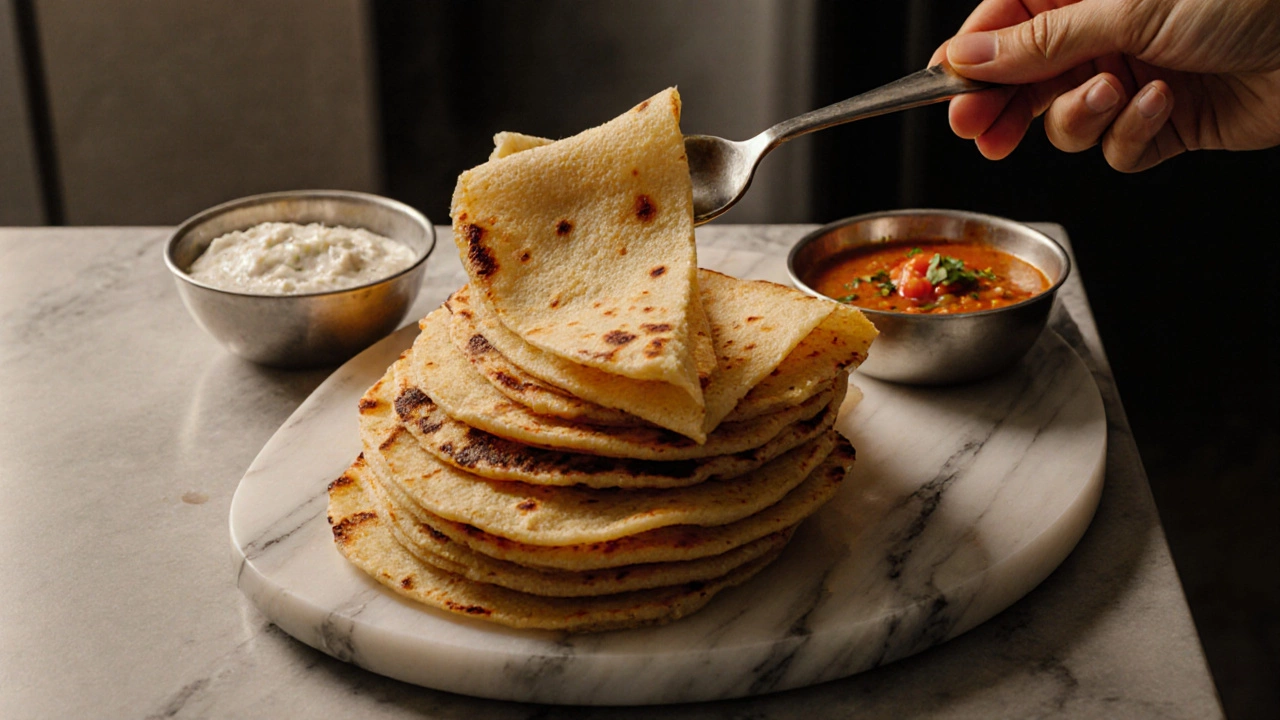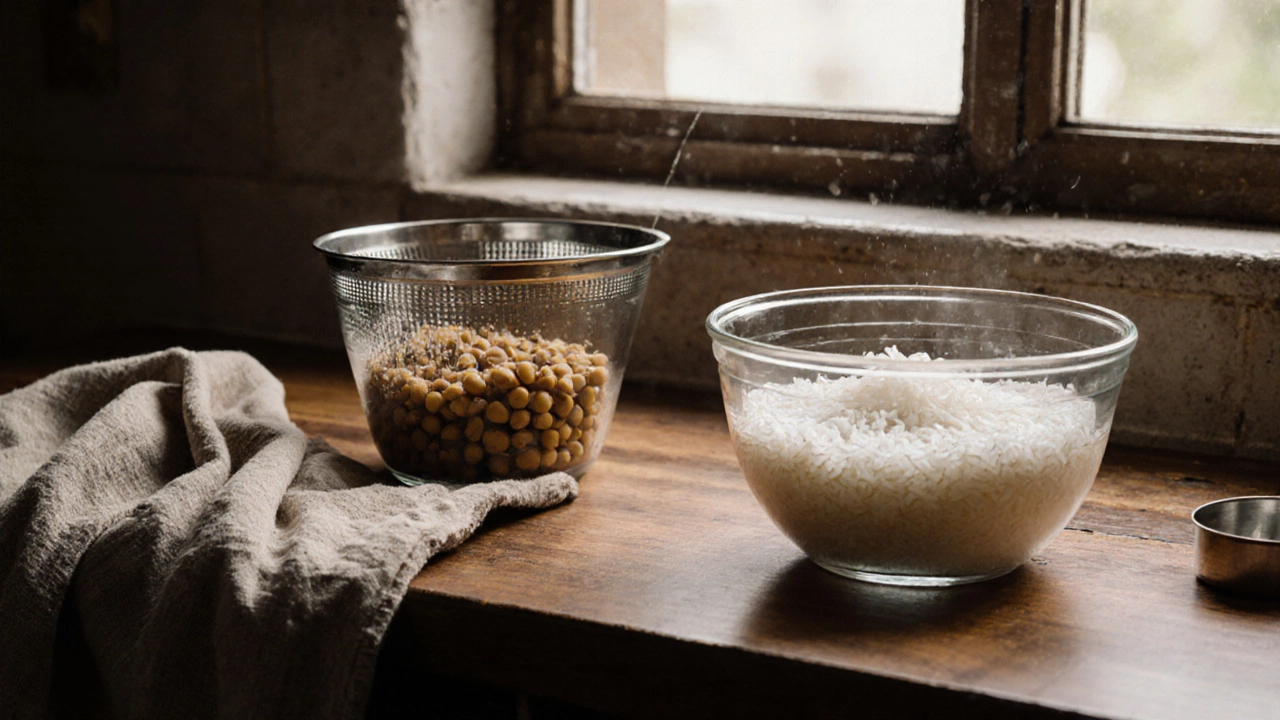Dosa Batter Fermentation Time Calculator
How Long Should Your Dosa Batter Ferment?
Enter your kitchen temperature to calculate the ideal fermentation time. This tool uses scientific principles and traditional knowledge to give you precise timing for perfect dosas.
When you’re trying to nail that crisp, airy dosa batter fermentation window, the clock becomes your kitchen ally-or your worst enemy. Too short, and the batter stays dense and sour; too long, and it over‑ferments, turning flat and tangy. Below you’ll find a step‑by‑step guide that tells you exactly how many hours to let your batter rest, why temperature matters, and what signs to watch for.
What Is Dosa Batter and Why Ferment It?
Dosa Batter is a fermented mixture of rice and urad dal that forms the base for South Indian crepes called dosa. The fermentation process creates natural bubbles, which give the batter its signature lightness and a faint, pleasant sourness that balances the rice’s sweetness.
Core Ingredients and Their Roles
- Rice provides the starch that forms the batter’s structure and browning surface.
- Urad Dal (split black gram) contributes proteins and the enzymes that feed the fermenting microbes.
- Fermentation introduces beneficial bacteria, mainly Lactobacillus, which produce carbon dioxide and lactic acid.
Typical Fermentation Time Frames
Most home cooks aim for a 6‑12 hour window, but the exact hours depend on three key variables: ambient temperature, starter culture strength, and the proportion of rice to dal.
| Temperature (°C / °F) | Typical Fermentation Time | Expected Batter Aroma |
|---|---|---|
| 20°C / 68°F | 12‑14 hrs | Lightly sour, faint fruity note |
| 24°C / 75°F | 8‑10 hrs | Balanced tang, active bubbles |
| 30°C / 86°F | 4‑6 hrs | Pronounced sourness, rapid rise |
| 35°C / 95°F | 2‑3 hrs | Very tangy, risk of over‑fermentation |
The table shows why a kitchen in Cape Town’s summer (around 28°C) may need only 6‑8 hours, while a cooler winter night (15°C) could stretch to 16‑18 hours.

Step‑by‑Step Fermentation Guide
- Soak the grains: Rinse 2 cups of rice and ½ cup of urad dal. Soak rice for 4‑6 hrs and dal for 6‑8 hrs. Longer soak helps break down starches, speeding up fermentation.
- Grind to a smooth paste: Drain water, then blend dal with a little fresh water until fluffy. Add rice and blend again to a thin batter (about the consistency of a pancake mix).
- Add salt and starter: Mix in 1‑2 tsp of sea salt. If you have leftover Idli Batter or a spoonful of previously fermented dosa batter, stir it in now. This inoculates the mix with robust bacteria.
- Cover and let ferment: Transfer to a wide, non‑metallic bowl, cover with a clean cloth, and place in the warmest spot of your kitchen. Record the start time.
- Check for readiness: After the minimum time suggested by the temperature table, look for tiny bubbles on the surface, a slight increase in volume (5‑10 %), and a pleasant sour smell. If any of these are missing, give it another hour.
- Stir before cooking: Give the batter a gentle stir to redistribute bubbles, then heat a non‑stick pan and pour a ladleful. The batter should spread quickly and develop crisp edges within 1‑2 minutes.
Factors That Can Speed Up or Slow Down Fermentation
Understanding these helps you fine‑tune the process without guessing.
- Temperature control: A simple insulated box or a turned‑off oven with the light on can add 5‑10°C, shaving hours off the cycle.
- Starter culture strength: Using a fresh, active starter (like yesterday’s batter) can cut the time in half compared to starting from scratch.
- Water quality: Chlorinated tap water can inhibit bacterial growth. Use filtered or boiled‑cooled water for a healthier fermentation.
- Grain ratio: More urad dal relative to rice yields more protein, which fuels bacteria, leading to quicker rise. A 3:1 rice‑to‑dal ratio is a common sweet spot.
- Cover material: Cloth allows airflow, which many traditional cooks prefer. A sealed lid creates an anaerobic environment, speeding up lactic acid production but risking over‑sourness.
Troubleshooting Common Problems
| Problem | Likely Cause | Solution |
|---|---|---|
| No bubbles after 12 hrs | Low ambient temperature or weak starter | Move batter to a warmer spot (e.g., near a warm stove) or add a spoonful of active idli batter. |
| Overly sour, unpleasant smell | Fermented too long or at too high temperature | Reduce fermentation time; store batter in the refrigerator once it’s ready to slow further activity. |
| Batter too watery | Excess water during grinding or too much fermentation | Add a little rice flour (1‑2 tbsp) and let rest 30 min before cooking. |
| Flat, dense dosas | Insufficient fermentation or low temperature | Ensure batter reaches the bubble stage; increase temperature or extend time by 2‑3 hrs. |

How to Store Fermented Batter
Once your batter reaches the ideal sourness, you have two options:
- Refrigerate: Transfer to a sealed container and keep at 4°C. Fermentation slows dramatically, giving you up to a week of usable batter. Give it a gentle stir each day.
- Freeze: Portion into ice‑cube trays, freeze, then transfer to a zip‑bag. Thaw overnight in the fridge and let it sit at room temperature for 30 minutes before cooking.
Never return frozen batter to the fridge for extended storage, as repeated freeze‑thaw cycles degrade texture.
Quick Reference Cheat Sheet
- Ideal fermentation window: 6‑12 hrs at 24‑30°C (75‑86°F).
- Key visual cue: Tiny bubbles on the surface and a 5‑10 % rise.
- Smell test: Pleasant sourness, no foul odor.
- Temperature hacks: Use a warm oven, insulated box, or a heating pad set on low.
- Storage: Refrigerate up to 7 days, freeze for longer.
Frequently Asked Questions
Can I use whole wheat instead of rice?
Yes, but whole wheat ferments slower and produces a denser batter. Increase the fermentation time by 2‑3 hrs and add a bit more water to keep the consistency thin.
What if my kitchen is cooler than 20°C?
Create a warm micro‑environment: place the bowl inside a turned‑off oven with the light on, wrap it in a thick towel, or use a rice cooker’s ‘keep warm’ setting without the heat. Expect the process to take 2‑4 extra hours.
Is it safe to eat over‑fermented batter?
If the batter smells foul (like rotten eggs) or develops mold, discard it. A strong sour smell is fine, but excessive tang can make the dosas unpleasant.
Can I add flavors (e.g., herbs) before fermenting?
Adding herbs or spices early can hinder bacterial activity. Mix them after fermentation, right before you pour the batter onto the pan.
How does dosa batter differ from idli batter?
Both use the same rice‑dal mix, but dosa batter is thinner and often fermented for a slightly shorter period, giving it a milder sourness. Idli batter is thicker, leading to fluffy steamed cakes.
With these guidelines, you can confidently set a timer, watch the signs, and serve perfectly airy dosas every time. Happy fermenting!











